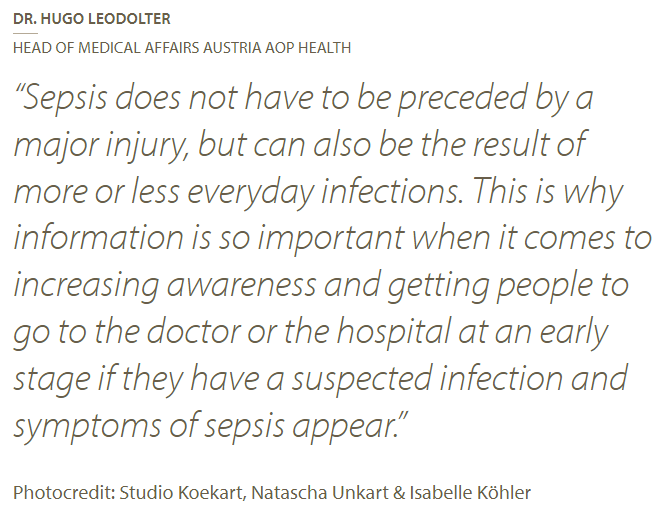World Sepsis Day falls on September 13. Sepsis, which kills more people in Austria each year than heart attacks, is caused by an infection which spreads through the body and damages our organs. A lot of people in the general public still do not know very much about this issue.
Sepsis is one of the most common causes of death around the world.[1] Around 2 million people in Europe suffer from this disease each year – 28,000 of them in Austria. The condition proves fatal for around 7,500 people across Austria.[2] By comparison, 4,293 people died of a heart attack in Austria last year.[3] But what makes sepsis so dangerous?
Understanding sepsis better
The answer is simple: Being unaware. Because sepsis is a lurking threat primarily affecting people with a weak immune system and intensive care patients. But older people roughly over the age of 60 and infants under the age of one can also be affected. Cancer patients, diabetics or the chronically ill, as well as alcoholics and drug addicts also display an increased risk of sepsis.
AOP Orphan Pharmaceuticals GmbH (AOP Health) feels obliged to face up to this challenge because the company has been involved in research and development on therapies for intensive care patients for 25 years. Dr. Hugo Leodolter, Head of Medical Affairs Austria at AOP Health, a pharmaceutical company focused on rare diseases and intensive care medicine, explains:
 |  |
How to recognize potential sepsis?
Septic patients often have a fever combined with severe chills, especially in the early stage. In contrast there are also cases of septicemia where affected patients have a low temperature (hypothermia). Rapid breathing and shortness of breath can also be symptoms of gradual sepsis, similarly to an increased heart rate or signs of infection, such as rashes, swellings, nausea, vomiting or hyperthermia, along with confusion or disorientation.
“A generally severe impairment and deterioration of the state of health is regarded as a general indication of sepsis. This means fast action is needed. Because in the event of severe sepsis, septic shock or late diagnosis the body is unable to maintain organ functions and the organs may fail. In other words, regardless of the infection site, the body can no longer handle the normal function of the organs. The result is that vital functions begin to shut down”, says Leodolter.
What is sepsis?
Sepsis means a life-threatening organ failure caused by patients’ dysregulated immune response to an infection. Triggers may include bacteria, viruses and fungi which infect areas of the body and spread rapidly throughout the whole body. Examples of causes include wounds, urinary tract infections through to pneumonia or even a mild case of the flu.
Every hour counts
Sepsis is an emergency where every hour counts. Anyone with a suspected infection and displaying at least one symptom of sepsis should visit a hospital immediately. The earlier the patient is treated, the greater the chances of survival.
Source: AOP Health
References:
[1] 20% of all deaths are caused by sepsis, WHO in ÖGARI [Austrian Society for Anaesthesiology, Rescuscitation and Intensive Care Medicine]: https://www.oegari.at/web_files/cms_daten/gari_pressemitteilung_welt-sepsis-tag_am_13._september_2020.pdf
[2] Uni Innsbruck: https://www.i-med.ac.at/mypoint/news/730395.html#:~:text=In%20Europa%20erkrankt%20jährlich%20etwa,pro%20Jahr%2C%207.500%20sterben%20daran.
[3] Statistics Austria, Causes of Death 2022



























